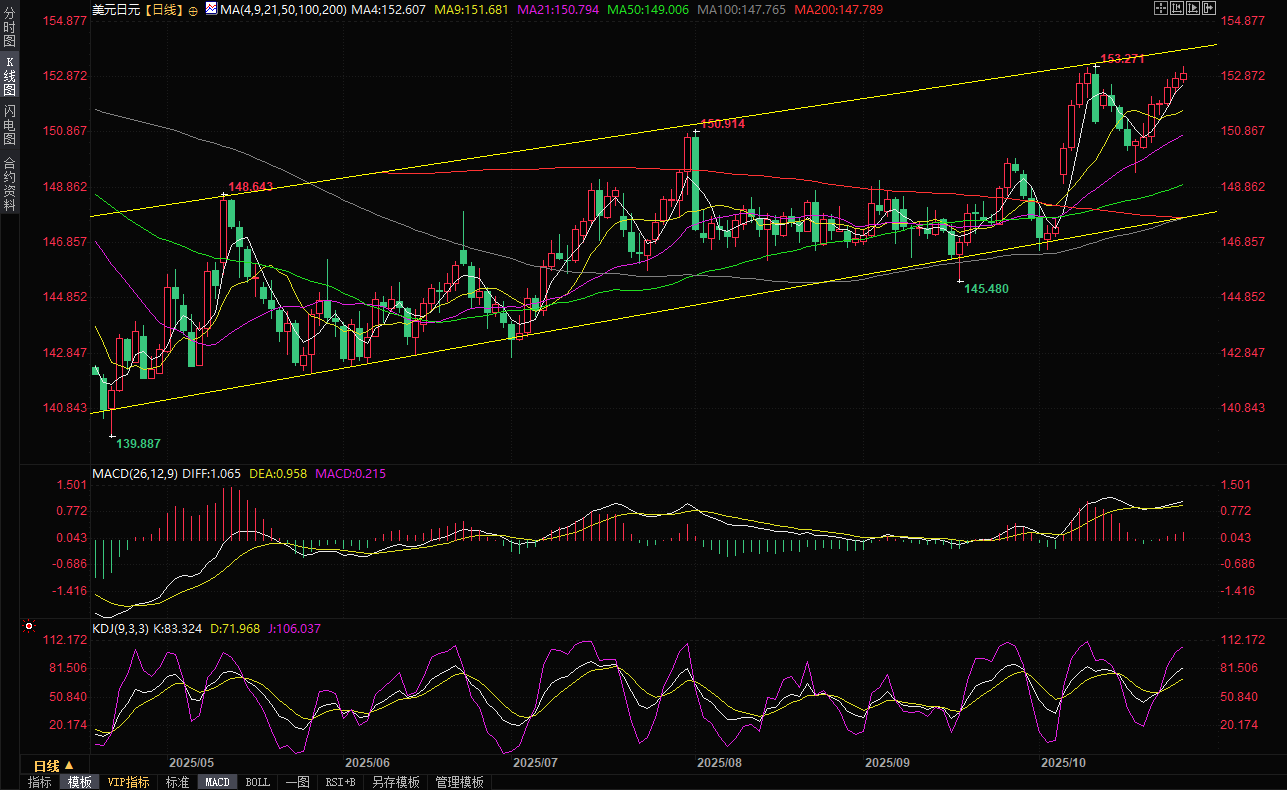USD/JPY climbs to two-week high as yen continues to weaken on fiscal concerns
2025-10-27 14:15:29
Meanwhile, data released earlier today showed that Japan's services sector inflation rose again in September, reinforcing market expectations of an imminent interest rate hike by the Bank of Japan (BoJ). This contrasts sharply with dovish expectations from the Federal Reserve (Fed), which could support the low-yielding yen and limit gains in USD/JPY.
Traders may also opt to wait and see ahead of a key Federal Reserve decision on Wednesday and a Bank of Japan policy update on Thursday.

Yen struggles to attract buyers despite rate hike expectations
Data released earlier on Monday showed that Japan's service sector producer prices rose for a second straight month in September, accelerating to 3.0% from 2.7% in August. Consumer inflation has exceeded the Bank of Japan's 2% target for more than three years, and the latest data bolsters the case for further policy tightening, but did little to boost the yen.
Japan's new Prime Minister Sanae Takaichi, seen as the heir apparent to former Prime Minister Shinzo Abe's economic policies, is known for her support for stimulus policies. This has raised concerns about Japan's fiscal health and clouded the prospect of further tightening by the Bank of Japan, limiting aggressive long bets on the yen and curbing further gains.
The U.S. Bureau of Labor Statistics reported last Friday that the overall Consumer Price Index (CPI) rose 0.3% in September, bringing the annual inflation rate to 3%. Excluding food and energy, the index rose 0.2% month-over-month, bringing the annual rate to 3%. This data fell short of market expectations and reaffirmed market expectations of a Federal Reserve interest rate cut later this week.
Traders also anticipate another rate cut at the December FOMC policy meeting, which has failed to help the dollar capitalize on its healthy rebound from a one-week low on October 17. Furthermore, the divergence in policy expectations between the Bank of Japan and the Federal Reserve could provide some support for the low-yielding yen and limit upside for USD/JPY ahead of key central bank events this week.
The Federal Reserve is scheduled to announce its decision at the end of its two-day policy meeting on Wednesday, followed by the Bank of Japan's policy update on Thursday. These prospects will be key to the next move in USD/JPY.
On the trade front, senior Chinese and American economic officials agreed on Sunday on the framework of a potential trade deal, which will be discussed when President Trump and Chinese President Xi Jinping meet later this week. This helped ease concerns about an all-out trade war between the world's two largest economies, potentially weakening the yen's safe-haven status.
USD/JPY could accelerate its rise by breaking through the 153.25-153.30 resistance zone
From a technical perspective, a sustained buy above the 153.25-153.30 area – the highest level since February hit earlier this month – would provide a fresh trigger for USD/JPY bulls.
Given that oscillators on the daily chart continue to gain positive momentum and have not yet entered overbought territory, the price may further target the 154.00 round number. The momentum may further extend to the 154.50 medium-term resistance level, and then to the 154.75-154.80 area and the 155.00 psychological level.
On the other hand, the Asian session low of 152.65 area may serve as immediate support. If it falls below this level, USD/JPY may slide towards the intermediate support of 152.25 and then to the 152.00 mark. A clear break below the latter may negate the bullish outlook and trigger technical selling, paving the way for further decline towards the 151.10-151.00 support level.

(USD/JPY daily chart, source: Yihuitong)
At 14:13 Beijing time, the USD/JPY exchange rate was 153.05/06.
- Risk Warning and Disclaimer
- The market involves risk, and trading may not be suitable for all investors. This article is for reference only and does not constitute personal investment advice, nor does it take into account certain users’ specific investment objectives, financial situation, or other needs. Any investment decisions made based on this information are at your own risk.





















